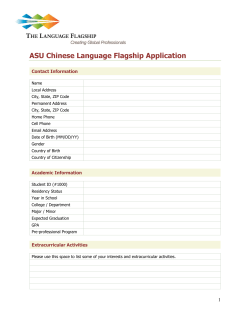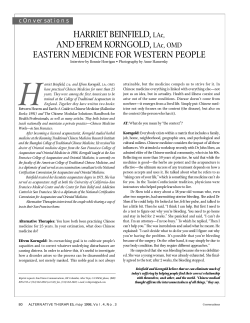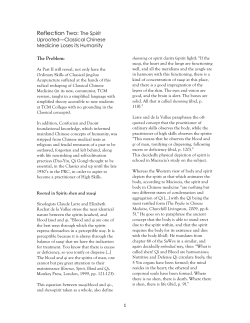
3. Chinese writing
Learning Chinese: A Foundation Course in Mandarin Julian K. Wheatley, MIT 3. Chinese writing Written Mandarin As noted above, Mandarin is often used to refer to the written language of China as well as to the standard spoken language. This is the language of composition learned in school and used by all educated Chinese regardless of the particular variety or regional languages that they speak. A Cantonese, for example, speaking Taishan Cantonese (Hoisan) at home and in the neighborhood, speaking something closer to standard Cantonese when s/he goes to Canton (city), and speaking Cantonese flavored Mandarin in certain formal or official situations, is taught to write a language that is different in terms of vocabulary, grammar and usage from both Hoisan and standard Cantonese. Even though s/he would read it aloud with Cantonese pronunciation, it would in fact be more easily relatable to spoken Mandarin in lexicon, grammar, and in all respects other than pronunciation. From Classical Chinese to modern written Chinese Written language always differs from spoken, for it serves quite different functions. But in the case of Chinese, the difference was, until the early part of the 20th century, extreme. For until then, most written communication, and almost all printed matter, was written in a language called Wényán in Chinese (‘literary language’), and generally known in English as Classical Chinese. As noted earlier, it was this language that served as a medium of written communication for the literate classes Classical Chinese was unlikely ever to have been a close representation of a spoken language. It is thought to have had its roots in the language spoken some 2500 years ago in northern China. That language, though still Chinese in the sense that it is ancestral to modern Chinese languages, would have differed quite significantly in sounds, grammar and vocabulary from any form of modern Chinese. Though Classical Chinese can be regarded as a different language from the modern, it was written in characters that have retained their basic shape to the present day, and these serve to preserve the connection between ancient and modern words whose pronunciation and grammatical context is radically different. While for English, spelling changes (that reflect changes in pronunciation), as well a high degree of word replacement, make Old English texts almost completely opaque to modern readers, ancient Chinese texts continue to look familiar to Chinese readers despite the changes that have taken place in the intervening years. Educated Chinese can read them aloud in modern pronunciation, Mandarin, say, or Cantonese. Without knowledge of the grammar and vocabulary of Classical Chinese, they may not fully understand them, but enough words – and more than words, sayings and phrases – have survived to modern times to make the writings of Confucius (5th – 6th century BCE), or the poems of Li Po (8th century AD) superficially accessible to the modern reader of Chinese. Classical Chinese is still used for certain kinds of formal or ritual writing, eg diplomas and inscriptions, much like Latin in western countries. It has also been a source of words, quotations, allusions, stories and even style that appear in the modern written g Learning Chinese: A Foundation Course in Mandarin Julian K. Wheatley, MIT language, as well as in speech, but relatively few people read the classical language well, and only a few specialists are still able to write it fluently. Since Classical Chinese was not based on an accessible spoken language, facility in writing it required memorizing large samples to act as models. Once learned, the classical language would tend to channel expression in conservative directions. Citation was the main form of argument; balance and euphony were crucial elements of style. These features did not endear it to the modernizers, and they sought to replace it with a language closer to the modern spoken (as noted in §2). They had a precedent, for all through Chinese history, there had in fact been genres of writing known as Báihuà (‘white = plain or vernacular language’) that were rich in colloquial elements. Such genres were not highly regarded or considered worthy as literary models, but they were well known as the medium of the popular novels of the Ming and Qing, such as Dream of the Red Chamber (also called the The Story of Stone), Monkey (also known as Journey to the West), or the Romance of the Three Kingdoms. Báihuà, though it retained classical elements, provided the early model for a more colloquial standard written language. Because norms within the newly emerging written language varied, and led to problems of consistency and clarity, some advocated a return to Classical Chinese as the written standard, and if it could have shed some of its stylistic affectations (such as the high value put on parallelism of structure and elaborate or archaic diction), Classical Chinese might have developed into a modern written norm much as Classical Arabic has become the written norm of the Arabic speaking world. But Classical Chinese was too closely associated with conservatism and insularity at a time when China was looking to modernize. Nevertheless, a new written norm does not arise overnight, and for at least the first half of the 20th century, a number of different styles across the range of classical to colloquial coexisted and vied for dominance. Following the Chinese revolution, written styles in Taiwan and the PRC diverged. In the PRC, political and other factors favored a more colloquial written style, whereas in Taiwan the influence of classical styles has remained stronger. Characters The earliest extensive examples of written Chinese date from late in the second millenium BCE. These are the so-called oracle bone inscriptions (jiǎgǔwén), inscribed or painted on ox bones and the bottom plate, the carapace, of tortoise shells. This early writing made use of characters whose form differs in appearance but which can be directly related to the modern characters (particularly the traditional characters that are still standard in Taiwan). In the Qin dynasty (221 – 206 BC), the script was modified and standardized as part of the reform of government administration. The resulting style, known as the ‘little seal’ (xiǎo zhuàn) is still used on seals (or ‘chops’). At first glance, little seal characters look quite unlike the modern, but a native reader can often discern the basic parts and figure them out. A script known as lìshū came into extensive use in the Han dynasty (202 BCE – 220 AD). Individual strokes in the lìshū style are described as having “silkworm’s head and swallow’s tail”. It is still used occasionally for writing large characters. The modern h Learning Chinese: A Foundation Course in Mandarin Julian K. Wheatley, MIT script, the kind generally used for printed matter, is based on the kǎishū ‘the model script’ that has been in use since before the period known as the Southern and Northern Dynasties (5th and 6th centuries). Other varieties of script were developed for handwriting (xíngshū ‘running script’) and calligraphy (cǎoshū ‘grass script’). Traditional and simplified characters In the past, simpler and more complex versions of characters have often co-existed. In many cases, the more complicated were used for formal correspondence and the simpler, for personal. In the 1950s however, as part of a program to promote literacy in the PRC, a set of simpler characters, most of them based on attested forms, were promoted as a general standard for all printed matter. Singapore adopted the new forms for most purposes, but Taiwan, Hong Kong and most overseas communities kept the traditional forms, and as a result, two types of (formal) characters are now in use in the Chinese speaking world. In Chinese, these are called fántǐzì ‘abundant-stroke-characters’ and jiǎntǐzì ‘simple-stroke-characters’, or in English, ‘traditional’ and ‘simplified’. The two types are illustrated below, using the phrase Zhōngguó huà ‘Chinese [spoken] language (middle-country speech)’: Traditional Simplified 中國話 中国话 Zhōngguó huà Zhōngguó huà The three characters cited illustrate the differences nicely. Many characters have only one form (like zhōng), or show slight differences between the two forms (like huà). Others (like guó) show significant differences but are easily relatable. Relatively few, no more than a few dozen, are completely different, and most of those are commonly encountered. So the differences between the two sets of characters are not as significant as might be imagined. A native speaker sees the relationship between the two fairly easily, and using context, moves from one to the other without much difficulty. Students generally write only one style, but they should be comfortable reading either. Homophony Characters represent syllable-length words (or rather, morphemes, the components of compounds). Since in Chinese these units are short, the chance of homophony is relatively high, more so than in English. In English words pronounced the same are often written the same, eg the ‘pens’ of ‘pig pen’ and ‘ink pen.’ But it is also common in English for different words of identical pronunciation to be written differently: ‘to, too, two’. Written Chinese is more comparable to the latter case: words with different (and unrelatable) meanings are written with different characters. A syllable such as shi can be written dozens of ways, depending on the meaning, as the famous Chinese linguist Chao Yuen Ren showed in a tour de force whose title was: i Learning Chinese: A Foundation Course in Mandarin Julian K. Wheatley, MIT 施氏食獅史 Shī shì shí shī shǐ. (Shi) clan eat lion story The tale of how Shi of the Shi clan ate the lion. Chao’s tale continues for another 100 or so characters, all pronounced shi on one of the four tones. It is written in the very concise prose of Classical Chinese (which is given modern sound values when read). Written in modern Chinese, there would be far less homophony; many of the single syllable words would, in fact, be compounds. So the story could probably be read aloud and understood. But Chao’s exercise makes the point nicely: characters are units of sound and meaning. Letters are units of sound only. Transcribing sound in characters Characters are sometimes used only for their sound values, with the usual meanings ignored. In this way, Chinese characters can be used to transcribe foreign sounds. So just as we can use Roman letters to write Chinese in pinyin, Chinese have used characters to write foreign languages, including English. Here is an example from a very simple Chinese English-teaching manual from the Mainland (and therefore written in simplified characters): 艾姆搜普利丝得吐斯衣油厄根 ài-mǔ sōu pǔ-lì-sī-dé tǔ sī-yī yóu è-gēn I’m so pleased to see you again. Characters are regularly used for their syllabic value, in this way, to transliterate personal names, names of places, as well as sounds: 沙士比亞 Shāshìbǐyà ‘Shakespeare’; 密西西比 Mìxīxībĭ ‘Mississippi’; 嘩啦huālā ‘splat’ [sound of crashing]. But because characters can only be used for syllabic units, the match is not usually as good as it would be in an alphabetic system, that can match a symbol to each consonant and vowel sound. A more precise match could be achieved by inserting an alphabetic transcription such as bopomofo or pinyin (see below) into a character text, but this practice is still rare. Pictographs, ideographs, logographs. Simple characters, or the basic components of more complicated ones, can often be traced back to pictorial representations, and for this reason characters are sometimes labeled pictographs. The earliest characters, the oracle bone inscriptions, look even more like pictures. But the majority of modern characters do not derive directly from attempts to represent objects pictorially, and even those that do, have become so conventionalized that it is only in rare cases that one can guess the meaning from the form alone. That is not to say that Chinese characters do not have certain aesthetic qualities that can be exploited in poetry and art, or that their pictorial qualities cannot be exploited for language learning as well; it is rather that the pictorial aspects of characters do not necessarily play a significant role in ordinary reading or writing. The term ideograph has also been applied to Chinese characters, sometimes with the implication that characters allow immediate access to meaning without reference to j Learning Chinese: A Foundation Course in Mandarin Julian K. Wheatley, MIT sound, or without reference to particular words. The fact that Chinese characters were borrowed into other languages such as Japanese, Korean, and Vietnamese to represent words that matched in meaning but not sound offer some support for such a notion. Indeed, it is true that the link between character and sound can vary. Cantonese speakers read Chinese with Cantonese sounds, while Mandarin speakers read them with Mandarin (much as Australians or Scots read English texts in their own pronunciation). But regardless of the particular language, understanding of the text is still dependent on linguistic contexts. Even in classical Chinese, the reader has to identify words and contexts that are linguistic, not just in the realm of thought, in order to perceive meaning. So, like pictographic, the term ideographic is not a very suitable characterization either. Writing systems are better named according to the units that they encode. Thus English is basically phonographic, with letters encoding sounds; but it also has considerable logographic elements (to, too, two; &; $). Chinese writing is primarily logographic (units encode words) but also has syllabo-graphic elements that connect syllables that are similar in sound. Taibei: Selling New Year scrolls. [JKW 1970] Representing the sounds of Chinese While characters do exhibit sound-based connections, the pronunciation of a particular character is not systematically indicated by its form. This can be an advantage, as we noted earlier, for it allows speakers of different regional languages, or even different languages in the case of Vietnamese, Korean and Japanese, to apply quite different sounds to the same graph. But for learners, it creates obvious difficulties. Learners need k Learning Chinese: A Foundation Course in Mandarin Julian K. Wheatley, MIT to be able to symbolize the pronunciation accurately for purposes of keeping track of material and internalizing correct pronunciation. (When Cantonese and speakers of other regional languages learn Mandarin, they need a transcription system for the same reasons.) Of even more importance, an alphabetic system of writing, which can be learned very quickly, speeds up the presentation of spoken language material. Alphabetic systems for writing Chinese date back at least to the 16th century. Most have made use of Roman letters, and are therefore called Romanizations. We can illustrate some of the systems, using the compound word for ‘Chinese language’ again: 1. Wade-Giles Chūngkuó huà 2. Yale Jūnggwó hwà 3. National Romanization Jong-guo huah 4. Zhùyīn Fúhào 5. Hànyǔ Pīnyīn Æ Æ Zhōngguó huà ㄓ ㄨ ㄥ = = = zh w eng ㄍ ㄨ ㄛˊ = = = g w ó ㄏ ㄨ ㄚ、 = = = h w à The Wade-Giles system (named for Thomas Wade, a Professor of Chinese at Cambridge University at the turn of 19th century who invented it, and Herbert A. Giles, a consular officer and later, Wade’s successor at Cambridge who incorporated it in his dictionary) was for many years used in most English language publications on China, as well as in library catalogues. It is well known for distinguishing the plain initial consonants from the aspirated (g from k, d from t, zh from ch etc. in the pinyin system) by placing an apostrophe after the latter: kuo versus k’uo, for example, or chung versus ch’ung. (This is phonetically quite sensible since both sounds are voiceless in Chinese.) The Yale system grew out of work performed by the War Department during World War II and was used in the Yale textbook series, familiar to several generations of students of Chinese. It is probably the most transparent of the Romanized transcription systems. National Romanization (Guóyŭ Luómăzì), a system that had official status in China during the 1930s, incorporates the tone in the spelling – notice there are no tone marks above the vowels – which makes it invaluable for learning and retaining tones. Hànyǔ Pīnyīn is the official system of the PRC and has been accepted by most of the rest of the world, including, recently, Taiwan. Zhùyīn Fúhào (‘transcription of sounds’), the system shown on the right of the others above, is called Bopo mofo, colloquially, after the first four letters of its alphabet. It has a longer history than pinyin, being based on a system created in 1919, called l Learning Chinese: A Foundation Course in Mandarin Julian K. Wheatley, MIT Zhùyīn Zìmŭ ‘transcription alphabet’ that was intended to serve as a fully fledged writing system. It was inspired by the Japanese ‘kana’ system, whose symbols derive from characters rather than Roman letters. Bopo mofo symbols have the advantage of looking Chinese and of not suggesting any particular English (or other language’s) sound values. In Taiwan, children, as well as many foreign students, learn to read with materials in which Bopo mofo is written vertically alongside the character text to indicate pronunciation. Hànyŭ Pīnyīn Pinyin (‘spelling the sound’) was developed and officially adopted by the PRC in the 1950s, and it is now used in textbooks, dictionaries and other reference books, computer input systems, and on road and shop signs there. In recent years, some schools in China have been encouraging children at certain stages in their education to write essays in pinyin to improve composition and style, and it is not unlikely that its functions will continue to expand in the future. It is sometimes claimed that pinyin (or any other such system of transcribing the sounds of Mandarin) cannot serve as a fully-fledged writing system because the degree of homophony in Chinese is such that some reference to characters is necessary for disambiguation. This is certainly true in the case of the shi-story cited earlier, and it might be true for Classical Chinese in general (if it is read out in modern pronunciation, as it usually is). But it is certainly not true for texts written in colloquial styles. Anything that can be understood in speech can be written and understood in pinyin. Many people email successfully in pinyin without even indicating the tones! The question is, using pinyin, how far one can stray from colloquial speech and still be understood. Written styles range from the relatively colloquial to the relatively classical, but if the latter can be understood when read aloud, then presumably they can be understood written in pinyin. Băihuā qífàng, băijiā zhèngmíng! 100-flowers together-blossom, 100-schools [of thought] contend Let a hundred flowers blossom and a hundred schools of thought contend! 百花 齊放,百家爭鳴 m Learning Chinese: A Foundation Course in Mandarin Julian K. Wheatley, MIT 4. Key Terms Peoples Republic of China (PRC) Bĕijīng (Peking) The Mainland Bĕipíng (Peiping) The Republic of China (ROC) Máo Zédōng Taiwan Chiang Kai-shek (Jiăng Jièshí) Hong Kong (Xiāng Găng) Sun Yat-sen (Sūn Yìxiān) Qīng (Manchu) dynasty (1644-1912) 1842 Míng (Chinese) dynasty (1368-1644) 1911 Yuán (Mongol) dynasty (1279-1368) 1949 Chinese oracle bone inscriptions (jiăgŭwén)) Guānhuà (officials’ language) little seal characters (xiăo zhuàn) Mandarin model script (kăishū) Guóyŭ (national language) traditional characters (fántĭzì) Pŭtōnghuà (ordinary language) simplified characters (jiăntĭzì) lingua franca homophony Classical Chinese (Wényán) pictographs Báihuà ideographs Táiyŭ logographs Taiwanese Mandarin Wade-Giles Hànyŭ Pīnyīn Zhùyīn Fúhào (Bopo mofo) dialects Regional languages: Cantonese; Shanghainese; Fujianese (Hokkien); Kejia (Hakka), etc. n Learning Chinese: A Foundation Course in Mandarin Julian K. Wheatley, MIT 5. Further reading and references Chen, Ping. Modern Chinese, Cambridge: Cambridge University Press, 1999. DeFrancis, John. The Chinese Language: Fact and Fantasy, Honolulu: University of Hawaii Press, 1984. DeFrancis, John, ed. ABC Chinese-English Dictionary, Honolulu: University of Hawaii Press, 1999. Erbaugh, Mary S. Difficult Characters: Interdisciplinary Studies of Chinese and Japanese Writing (Pathways to Advanced Skills, Publication series volume VI), National Resource Center, The Ohio State University, 2002. Hannas, William C. Asian’s Orthographic Dilemma, Honolulu: University of Hawai’i Press, 1997. Newnham, Richard. About Chinese, Penguin Books, 1971. Norman, Jerry. Chinese (Cambridge Language Surveys), Cambridge: Cambridge University Press, 1988. Ramsey, Robert S. The Languages of China, Princeton, New Jersey: Princeton University Press, 1987. Wilkinson, Endymion. Chinese History: A Manual (Harvard-Yenching Monograph Series, 52), Harvard University Asia Center. Revised and enlarged, 2000. Beijing: In the Imperial Palace [JKW 1982] o
© Copyright 2025





















